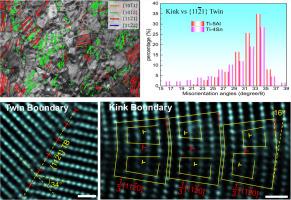Ti-Sn和Ti-Al合金的扭结诱导{112¯1}孪晶
IF 9.3
1区 材料科学
Q1 MATERIALS SCIENCE, MULTIDISCIPLINARY
引用次数: 0
摘要
变形孪晶通常是通过相干孪晶界面上的孪晶位错/断连的连续滑动来实现的。扭结与一系列滑动错位的堆积有关。孪生和扭结都会产生剪切带并引起晶体旋转。两种机制之间的主要区别在于,孪生导致特定的旋转角度,而与扭结相关的旋转角度是不特定的,与位错的密度有关。在这项工作中,我们研究了纯Ti, Ti- sn和Ti- al二元合金中的剪切带。% Sn和5 at。% Al)经受高应变率冲击。这些剪切带的特征为{101¯21¯2}、{112¯22¯2}和{112¯12¯1}孪晶。特别是Sn或Al的加入显著增强了{112¯12¯1}孪晶的激活,而抑制了{112¯22¯2}孪晶的激活。更重要的是,Ti-Sn和Ti-Al二元合金中的{112¯12¯1}孪晶表现出扭结带的特征,即它们的边界由基底位错壁组成,它们的错取向角小于理想的孪晶错取向角。原子分辨率表征表明,这些{112¯12¯1}孪晶是由扭结带演化而来的,这是由于晶界位错的特点和基底<;a>;Ti-Sn和Ti-Al二元合金中的位错。第一性原理计算进一步证实了Sn和Al促进基底<;a>;混乱。分子静力学/动力学模拟证实,{112¯12¯1}相干孪晶界可以通过基础<;a>;混乱。因此,我们得出结论,{112¯12¯1}孪生可以通过与基部成核、滑动和图案相关的扭结机制发生。混乱。本文章由计算机程序翻译,如有差异,请以英文原文为准。


Kinking-induced {112¯1} twin in Ti-Sn and Ti-Al alloys
Deformation twinning is generally operated via successive gliding of twinning dislocations/disconnections on coherent twin interface. Kinking is associated with the pileup of an array of gliding dislocations. Both twinning and kinking generate shear band and cause crystal rotation. The major difference between two mechanisms is that twinning causes a specific rotation angle while rotation angle associated with kinking is unspecific, related to the density of dislocations. In this work, we investigated shear bands in pure Ti, Ti-Sn and Ti-Al binary alloys (4 at.% Sn and 5 at.% Al) subjected to high strain rate impact. These shear bands are characterized to be {10}, {11} and {11} twins. Especially, the addition of Sn or Al significantly enhances the activation of {11} twins while inhibiting {11} twins. More importantly, the {11} twins in Ti-Sn and Ti-Al binary alloys exhibit the feature of kink bands, i.e., their boundaries are composed of basal dislocation walls and their misorientation angles are lower than the ideal twin misorientation angle. Atomic-resolution characterization reveals that these {11} twins evolve from kink bands because of the characters of dislocations at the boundary and the lower gliding resistance of basal 〈a〉 dislocations in Ti-Sn and Ti-Al binary alloys. First-principles calculations further confirm that Sn and Al promote the activation of basal 〈a〉 dislocations. Molecular statics/dynamic simulations confirm that {11} coherent twin boundary can be well reproduced by piling up and relaxing basal 〈a〉 dislocations. We thus conclude that {11} twinning can occur via kinking mechanism associated with nucleation, gliding and patterning of basal 〈a〉 dislocations.
求助全文
通过发布文献求助,成功后即可免费获取论文全文。
去求助
来源期刊

Acta Materialia
工程技术-材料科学:综合
CiteScore
16.10
自引率
8.50%
发文量
801
审稿时长
53 days
期刊介绍:
Acta Materialia serves as a platform for publishing full-length, original papers and commissioned overviews that contribute to a profound understanding of the correlation between the processing, structure, and properties of inorganic materials. The journal seeks papers with high impact potential or those that significantly propel the field forward. The scope includes the atomic and molecular arrangements, chemical and electronic structures, and microstructure of materials, focusing on their mechanical or functional behavior across all length scales, including nanostructures.
 求助内容:
求助内容: 应助结果提醒方式:
应助结果提醒方式:


